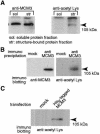MCM3AP, a novel acetyltransferase that acetylates replication protein MCM3
- PMID: 11258703
- PMCID: PMC1083822
- DOI: 10.1093/embo-reports/kve026
MCM3AP, a novel acetyltransferase that acetylates replication protein MCM3
Abstract
The MCM proteins are essential for the initiation of DNA replication. We have isolated an MCM3-associated protein (MCM3AP) in a two-hybrid screen using MCM3. Here we demonstrate that MCM3AP is an acetyltransferase which acetylates MCM3 and that chromatin-bound MCM3 is acetylated in vivo. The MCM3 acetylase, MCM3AP, is also chromatin-bound. This study also indicates that MCM3AP contains putative acetyl CoA binding motifs conserved within the GCN5-related N-acetyltransferase superfamily. Mutation of those motifs significantly inhibits the MCM3 acetylase activity. Over-expression of MCM3AP inhibits DNA replication, whereas mutation of the acetylase motifs abolishes this effect, suggesting that acetylation plays a role in DNA replication. Taken together, we suggest that MCM3 acetylation is a novel pathway which might regulate DNA replication.
Figures




Similar articles
-
The MCM3 acetylase MCM3AP inhibits initiation, but not elongation, of DNA replication via interaction with MCM3.J Biol Chem. 2002 Nov 8;277(45):43121-5. doi: 10.1074/jbc.C200442200. Epub 2002 Sep 10. J Biol Chem. 2002. PMID: 12226073
-
Identification of a novel MCM3-associated protein that facilitates MCM3 nuclear localization.J Biol Chem. 1998 Aug 28;273(35):22177-80. doi: 10.1074/jbc.273.35.22177. J Biol Chem. 1998. PMID: 9712829
-
Identification of carboxyl-terminal MCM3 phosphorylation sites using polyreactive phosphospecific antibodies.J Biol Chem. 2007 Mar 23;282(12):9236-43. doi: 10.1074/jbc.M609256200. Epub 2007 Jan 23. J Biol Chem. 2007. PMID: 17244605
-
Functional analysis of the p300 acetyltransferase domain: the PHD finger of p300 but not of CBP is dispensable for enzymatic activity.Nucleic Acids Res. 2001 Nov 1;29(21):4462-71. doi: 10.1093/nar/29.21.4462. Nucleic Acids Res. 2001. PMID: 11691934 Free PMC article.
-
The silencing complex SAS-I links histone acetylation to the assembly of repressed chromatin by CAF-I and Asf1 in Saccharomyces cerevisiae.Genes Dev. 2001 Dec 1;15(23):3169-82. doi: 10.1101/gad.929001. Genes Dev. 2001. PMID: 11731480 Free PMC article.
Cited by
-
Cell array-based intracellular localization screening reveals novel functional features of human chromosome 21 proteins.BMC Genomics. 2006 Jun 16;7:155. doi: 10.1186/1471-2164-7-155. BMC Genomics. 2006. PMID: 16780588 Free PMC article.
-
HBO1 histone acetylase activity is essential for DNA replication licensing and inhibited by Geminin.Mol Cell. 2010 Jan 15;37(1):57-66. doi: 10.1016/j.molcel.2009.12.012. Mol Cell. 2010. PMID: 20129055 Free PMC article.
-
NuMA influences higher order chromatin organization in human mammary epithelium.Mol Biol Cell. 2007 Feb;18(2):348-61. doi: 10.1091/mbc.e06-06-0551. Epub 2006 Nov 15. Mol Biol Cell. 2007. PMID: 17108325 Free PMC article.
-
Recessive Charcot-Marie-Tooth and multiple sclerosis associated with a variant in MCM3AP.Brain Commun. 2019 Sep 3;1(1):fcz011. doi: 10.1093/braincomms/fcz011. eCollection 2019. Brain Commun. 2019. PMID: 32954258 Free PMC article.
-
SIR2 modifies histone H4-K16 acetylation and affects superhelicity in the ARS region of plasmid chromatin in Saccharomyces cerevisiae.Nucleic Acids Res. 2006;34(19):5426-37. doi: 10.1093/nar/gkl678. Epub 2006 Sep 29. Nucleic Acids Res. 2006. PMID: 17012273 Free PMC article.
References
-
- Chen H., Lin, R.J., Xie, W., Wilpitz, D. and Evans, R.M. (1999) Regulation of hormone-induced histone hyperacetylation and gene activation via acetylation of an acetylase. Cell, 98, 675–686. - PubMed
-
- Cheung W.L., Briggs, S.D. and Allis, C.D. (2000) Acetylation and chromosomal functions. Curr. Opin. Cell. Biol., 12, 326–333. - PubMed
-
- Coverley D., Wilkinson, H.R., Madine, M.A., Mills, A.D. and Laskey, R.A. (1998) Protein kinase inhibition in G2 causes mammalian Mcm proteins to reassociate with chromatin and restores ability to replicate. Exp. Cell Res., 238, 63–69. - PubMed
Publication types
MeSH terms
Substances
LinkOut - more resources
Full Text Sources
Other Literature Sources
Molecular Biology Databases

